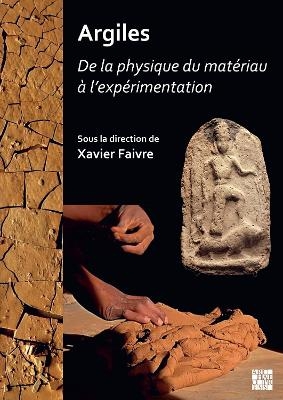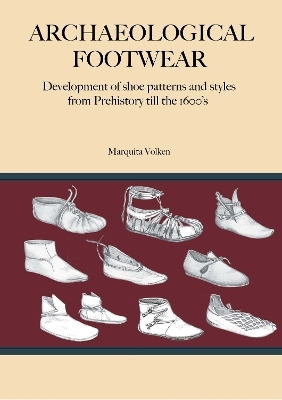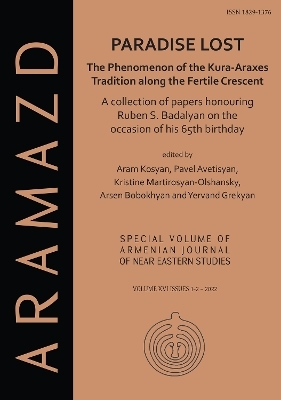
Argiles
Archaeopress (Verlag)
978-1-78969-420-8 (ISBN)
- Titel z.Zt. nicht lieferbar
- Versandkostenfrei innerhalb Deutschlands
- Auch auf Rechnung
- Verfügbarkeit in der Filiale vor Ort prüfen
- Artikel merken
Argiles. De la physique du matériau à l’expérimentation brings together the proceedings of four study days of the ‘Clay’ Collective Program (2018-2020) of the CNRS Joint Research Unit, Archaeology and Sciences of Antiquity (UMR 7041 - ArScAn, Nanterre), on the theme of ‘studying materiality’. The study of this polymorphic material has focused on four complementary areas: physical properties, construction, artefacts and texts relating to clay. As a forum for cross-disciplinary exchange, the meetings and then the volume itself form and opportunity to share the continuities, specifics, technical and cultural convergences or divergences of working with clay. The three parts correspond to the themes covered during these days:
I. Formation, structure, characterization, definitions of a material deals with the physics of clays, the geomorphology of clay landscapes, clay construction, the restoration of architectural remains, cuneiform tablets and clay objects, and finally mentions of clay in Mesopotamian texts, Linear B and Egyptian hieroglyphs.
II. Uses of clays and clay soils: from ‘unfired’ to ‘fired’ is devoted to these two states of clay: ‘unfired’ clay is explored through the geomorphology of the ‘clay country’ that is Mesopotamia, and earthen architecture from Cyprus to Western Europe, from the Neolithic to Roman times is investigated; ‘fired’ clay focuses on bricks and ceramics, which illustrate the transition between the two states, then on ovens and cooking devices, and the possible connections between Mesopotamian texts, the archaeology of the ancient Near East and experimentation.
III. Reproduction in clay: reconstruction, protocol, experimentation retraces several experimental approaches around ceramics and construction in the Near Eastern, Minoan, Egyptian and Western worlds.
Overall the book brings together 28 contributors, including university teachers, researchers, engineers, doctoral and post-doctoral students, attached to several teams of the Argiles unit as well as other laboratories and institutes in France and abroad. Each has enriched, through their specialism, their knowledge or their individual experience, an aspect of or an approach to clay and clay soils.
Xavier Faivre is a research engineer at the CNRS, in UMR 7041 ‘Archaeologies and sciences of Antiquity’ (ArScAn-HAROC), Nanterre (France). As an archaeologist and ceramic specialist since 1988, he has participated in numerous archaeological excavation missions in Syria, Turkey and Lebanon. He was naturally interested in the abundant multifaceted clay productions of Mesopotamia, ‘country of clay’, comparing archaeological data and cuneiform Mesopotamian texts written on clay. In this capacity, since 2017 he has directed the interdisciplinary collective program, Argiles, extended to all chrono-cultural fields, from Prehistory to the Middle Ages.
Avant-propos
I. FORMATION, STRUCTURE, CARACTERISATION, DEFINITIONS D’UN MATERIAU
1. PHYSIQUE DU MATERIAU
Les argiles : une composition chimique simple, des propriétés étonnantes - Clays: a simple chemical composition, amazing properties – Fabien Thomas
Pays et paysages de l’argile. Approche géomorphologique des milieux argileux - Clay landscapes: a geomorphic introduction – Bruno Comentale
2. ARGILES ET CONSTRUCTIONS
Géoarchéologie de la construction en terre crue au Néolithique : l’apport de la micromorphologie - Geoarchaeology of mud construction in the Neolithic: the contribution of micromorphology – Julia Wattez, Alessandro Peinetti, Pantelitsa Mylona
3. ARGILES ET RESTAURATIONS
Terre crue et archéologie : de la physique du matériau à la restauration de vestiges architecturaux - Unbaked clay and archaeology: from the physics of the material to the conservation of architectural remains – Mathilde Gelin
La conservation-restauration des tablettes cunéiformes et des objets en terre crue - A conservation treatment for unbaked cuneiform tablets – Anne Liégey
4. DES ARGILES ET DES TEXTES
Les mots pour dire l’argile - The words for clay – Xavier Faivre
Écrire sur argile. La matérialité des textes cunéiformes - Writing on clay: the materiality of cuneiform texts – Cécile Michel
L’argile pour écrire les mots. De la confection au recyclage des tablettes cunéiformes - Clay for writing words. From making to recycling cuneiform tablets – Xavier Faivre
Le matériau « argile » à l’époque mycénienne : réflexions sur les textes en linéaire B - Clay as a material in the Mycenaean period: Thoughts on the Linear B texts – Françoise Rougemont
Le travail du potier d’après la Satire des métiers - The potter’s work from the Satire of Trades – Adeline Bats
II. USAGES DES ARGILES ET TERRES ARGILEUSES : DU « CRU » AU « CUIT »
1. LE « CRU » : GEOMORPHOLOGIE, ARCHITECTURE ET ARTEFACTS
Mésopotamie
De la montagne à la tablette. Les argiles en Mésopotamie, une illustration du cycle d’érosion – From mountain to tablet. Clays in Mesopotamia, an illustration of the erosion cycle – Bruno Comentale
Chypre
On ne s’improvise pas maçon : la reconstitution de constructions néolithiques, Khirokitia (Chypre) - You don’t become a mason just like that: reconstructing Neolithic constructions, Khirokitia, Cyprus – Odile Daune-Le Brun
Gaule
Récipients et structures de stockage en terre crue au Néolithique et à l’âge du Bronze dans la moitié sud de la France (5000-800 av. J.-C.) : études de cas - Earthern containers and storage structures in Neolithic and Bronze Age in the southern half of France (5000-800 BC): case studies – Nina Parisot avec la collaboration d’Éric Thirault, Julien Cousteaux, Jean-Claude Daumas, Anne Duny et Robert Laudet
Crue ou cuite… l’argile dans la construction des séchoirs et fumoirs en Gaule romaine - Raw or fired… Clay in the construction of dryers and smokers in Roman Gaul – Guillaume Huitorel
2. LE « CUIT » : BRIQUES, CERAMIQUES, FOURS ET DISPOSITIFS DE CUISSON
Le passage du « cru » au « cuit »
De la brique crue à la brique cuite dans la Mésopotamie ancienne - From sundried brick to baked brick in ancient Mesopotamia – Martin Sauvage
De l’environnement géologique à la lame mince : retrouver le « cru » dans le « cuit » - From geological environment to thin-section: how to find the “raw” materials in “fired” vessels? – Mathilde Jean
Fours et dispositifs de cuisson
Dans les textes mésopotamiens
Les types de fours dans les textes mésopotamiens et leur réalité matérielle dans les fouilles archéologiques : l’apport des listes lexicales - Types of kilns in Mesopotamian texts and their material reality in archaeological excavations: the contribution of lexical lists – Xavier Faivre
Les fours en argile dans la Babylonie des deuxième et premier millénaires av. J.-C. : apports complémentaires de la documentation textuelle - Clay ovens in second and first millennia BCE Babylonia: Additional evidence from the textual record – Laura Cousin
Dans l’archéologie du Proche et du Moyen-Orient
L’épreuve du feu. Les fours à céramiques entre contraintes techniques et choix culturels : approche expérimentale aux données archéologiques et ethnographiques - Trial by fire. Ceramic kilns between technical constraints and cultural choices: an experimental approach to archaeological and ethnographic data – Johnny Samuele Baldi
Construire un four – Building a kiln – Claire Padovani
III. REPRODUIRE DANS L’ARGILE : RECONSTITUTION, PROTOCOLE, EXPERIMENTATION
1. CERAMIQUES
Orient
Façonner des pots à l’aide de l’énergie du mouvement rotatif : une expérimentation sur les logiques et les gestes opératoires – Shaping pots using the energy of rotary motion: an experiment on the logic and operational gestures – Armance Dupont-Delaleuf et Kostalena Michelaki
Du geste à la forme : reproduire des vases des IIIe et IIe millénaires av. J.-C. du bassin du Haut-Khabur (Syrie du nord-est) - From gesture to shape: reproducing vessels from the 3rd and 2nd millennia BC of the Upper Khabur Basin (northeast Syria) – Xavier Faivre
Monde minoen
Reproduire une larnax minoenne : enquête chez les potiers de Margaritès. L’extraction de l’argile et la préparation de la pâte - Reproducing a Minoan larnax: investigation with the potters of Margarites. The extraction of clay and the preparation of the clay paste – Sarah Georgel-Debedde
Un protocole expérimental de reconstitution du fonctionnement des lampes minoennes en terre cuite - An experimental protocol for reconstructing the functioning of Minoan terracotta lamps – Bastien Rueff
Occident
Expérimentations sur l’utilisation des pots au Néolithique final dans le sud de la France. Une contribution aux études fonctionnelles - Experiments on the use of pots in the late Neolithic in the south of France. A contribution to functional studies – Pauline Debels
Expérimentation de céramique sigillée - Experimentation with terra sigillata – Lucile Bolot
2. CONSTRUCTION
Occident
Les silos en terre crue : expérimentation sur les techniques de construction au Néolithique et à l’âge du Bronze – Earthen Silos : experiments on construction techniques in the Neolithic and Bronze Age – Nina Parisot
Égypte
Construction d’un réchaud domestique mobile ou « kanun » Village de Abu Musallam, région de Gizà, Égypte. 2018 - Construction of a mobile domestic stove or “kanun” Village of Abu Musallam, Giza region, Egypt. 2018 – Sylvie Marchand
Reconstruction d’un four à pain par l’image. Village de Abu Musallam, région de Gizà, Égypte. 2018 - The reconstruction of a bread oven using images. Village of Abu Musallam, Giza region, Egypt. 2018 – Sylvie Marchand
| Erscheinungsdatum | 03.10.2023 |
|---|---|
| Verlagsort | Oxford |
| Sprache | französisch |
| Maße | 203 x 290 mm |
| Gewicht | 517 g |
| Themenwelt | Geisteswissenschaften ► Archäologie |
| ISBN-10 | 1-78969-420-5 / 1789694205 |
| ISBN-13 | 978-1-78969-420-8 / 9781789694208 |
| Zustand | Neuware |
| Haben Sie eine Frage zum Produkt? |
aus dem Bereich


